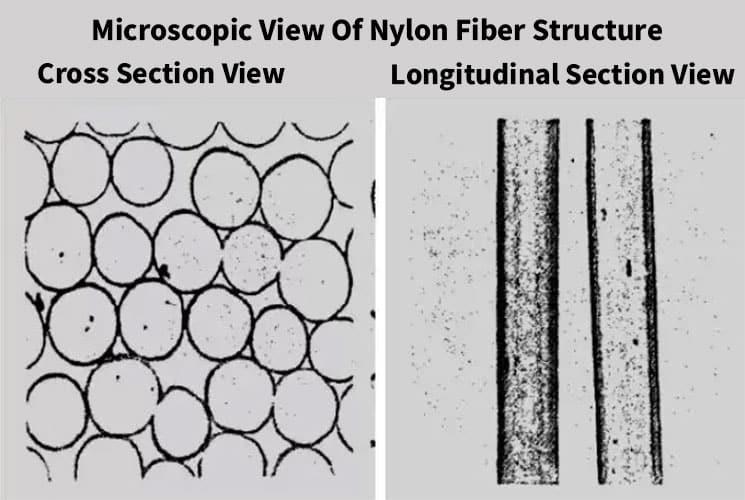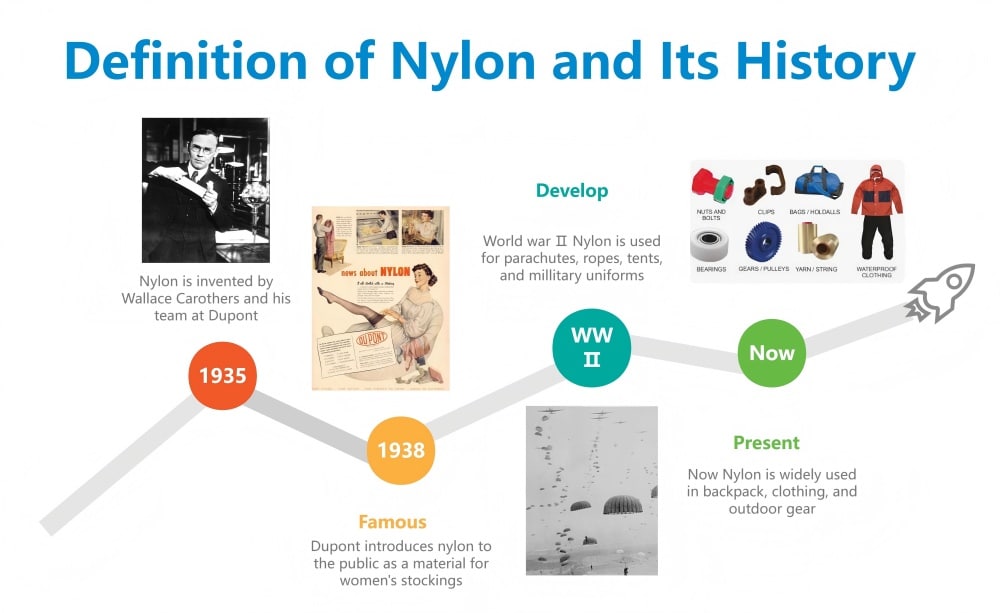Enterprise News
What is Nylon? Everything You Need to Know About This Versatile Fabric
Definition of Nylon and Its History

Main Features of Nylon
Nylon’s popularity isn’t an accident — it’s packed with properties that make it one of the most versatile fabrics in the world. Here are its key features:
- Lightweight – Think of nylon as the “featherweight champion” of fabrics — it weighs very little but can handle heavy loads. This makes it perfect for backpacks, where every gram counts.
- Strong & Durable – High tensile strength, ideal for heavy loads.
- High Abrasion Resistance – Nylon resists wear and tear extremely well. Even when scraped against rough surfaces, it holds up far better than many natural fibers, extending the lifespan of gear.
- Elastic and Flexible– Nylon can stretch slightly under tension and return to its original shape. This elasticity prevents permanent deformation and helps gear maintain its structure.
- Quick-Drying – Unlike cotton, which soaks up and holds water, nylon repels moisture and dries fast. That’s why nylon backpacks don’t stay soggy after a rain shower.
- Smooth Texture – Its surface is naturally smooth and can be woven for a glossy, sleek finish or textured for a matte, rugged look.
- Resistance to Mold and Mildew — Nylon doesn’t absorb much water, so it’s less likely to harbor mold or develop musty smells.
- Dye-Friendly — Nylon takes dye well, producing vibrant, long-lasting colors from deep black tactical packs to neon sports bags.
Common Types of Nylon
Nylon 6
Made from a single type of monomer, Nylon 6 is softer, has high elasticity, and excellent dye absorption. Common in apparel and lightweight backpacks.
- Structure: Made from a single type of monomer called caprolactam.
- Key Traits: Slightly softer, smoother texture, high elasticity.
- Uses: Apparel, lightweight backpacks, outdoor clothing.
- Backpack Benefit: Comfortable against the skin, good color vibrancy.
Nylon 66
Constructed from two different monomers, Nylon 66 offers greater heat resistance, stiffness, and abrasion resistance. Preferred for heavy-duty backpacks and outdoor gear.
- Structure: Made from two monomers (hexamethylenediamine and adipic acid).
- Key Traits: Higher melting point, greater abrasion resistance, more rigid.
- Uses: Heavy-duty backpacks, luggage, military gear.
- Backpack Benefit: Excellent for rough handling and extreme environments.
Ripstop Nylons
Enhanced versions with weaving techniques or treatments for higher tear resistance, often used in tactical and expedition backpacks.
- Structure: Woven with reinforcement threads in a crosshatch pattern.
- Key Traits: Prevents small tears from spreading, lightweight.
- Uses: Tents, kites, parachutes, lightweight backpacks.
- Backpack Benefit: Ideal for ultralight hiking packs.
Ballistic Nylons
Enhanced versions with weaving techniques or treatments for higher tear resistance, often used in tactical and expedition backpacks.
- Structure: Very dense weave, often 2×2 basket weave.
- Key Traits: Extremely tough, high resistance to punctures and abrasion.
- Uses: Military gear, motorcycle jackets, high-end travel luggage.
- Backpack Benefit: Maximum durability for urban and adventure travel.
Analogy:
Think of Nylon 6 as the “athletic runner” (flexible and smooth) and Nylon 66 as the “armored soldier” (tough and rigid). Ripstop is like a “self-healing fabric” for small cuts, and Ballistic Nylon is the “tank” of the fabric world.
Key Applications of Nylon
Nylon’s mix of strength, flexibility, and resistance to wear makes it a true all-rounder. From everyday clothing to heavy-duty industrial gear, this fabric finds its way into countless products.
1. Apparel
-
Why: Soft, elastic, and easy to dye for vibrant colors.
-
Examples: Sportswear, swimwear, windbreakers, leggings.
-
Benefit: Feels comfortable while staying durable and quick-drying.
2. Backpacks and Bags
-
Why: Lightweight yet strong, resists tearing and abrasion.
-
Examples: Hiking packs, travel backpacks, school bags.
-
Benefit: Handles heavy loads, survives rough travel, and dries fast if caught in rain.
3. Outdoor & Camping Gear
-
Why: Performs well in extreme weather and resists water absorption.
-
Examples: Tents, sleeping bags, hammocks.
-
Benefit: Reliable for hikers, campers, and adventurers.
4. Industrial Applications
-
Why: High tensile strength and chemical resistance.
-
Examples: Conveyor belts, fishing lines, safety harnesses.
-
Benefit: Can handle heavy-duty, high-stress environments.
5. Everyday Items
-
Why: Affordable, versatile, and easy to shape.
-
Examples: Umbrellas, shoelaces, luggage liners.
-
Benefit: Makes daily life more convenient without adding bulk.
Quick analogy:
If fabrics were tools, nylon would be the Swiss Army knife — ready for just about any job, big or small.
Why Nylon is Perfect for Backpacks
Backpacks face constant stress from weight, movement, and the environment. Nylon excels because it combines strength, lightness, and weather resistance. For example, a 420D Nylon Oxford backpack can withstand years of daily commuting, while a 1000D Ballistic Nylon hiking pack endures rugged mountain expeditions.
Comparison with Other Fabrics
| Fabric | Strength | Weight | Water Resistance | Cost |
|---|---|---|---|---|
| Nylon | High | Light | Good (with coating) | Medium |
| Polyester | Medium | Light | Good UV resistance | Low |
| Canvas | High | Heavy | Low unless treated | Medium |
| Cordura (Nylon) | Very High | Medium | Good | High |
| Oxford (Nylon/Poly) | Medium | Light | Good | Low-Medium |
Sustainability & the Future of Nylon
Traditional nylon production is energy-intensive and petroleum-based, but the industry is evolving. Recycled nylon from post-consumer waste (like discarded fishing nets) is now widely available, reducing environmental impact. Brands are investing in bio-based nylons and closed-loop recycling systems to make the material more sustainable without losing performance.
FAQ
Is Nylon waterproof?
No, nylon itself is not waterproof, but it can be treated or coated (e.g., with PU or silicone) to make it water-resistant or waterproof.
How long does a Nylon backpack last?
With proper care, a high-quality nylon backpack can last 5–10 years or more, depending on usage and fabric type.
Is recycled Nylon as strong as new Nylon?
Yes, recycled nylon can match the strength of virgin nylon, though the quality depends on the source material and processing method.
is nylon a synthetic fiber?
Yes — nylon is a synthetic fiber.
It was the first fully synthetic fiber made entirely from petrochemicals, invented in 1935 by a DuPont team led by Wallace Carothers. Unlike natural fibers such as cotton or wool, which come from plants or animals, nylon is created through a chemical process called polymerization, using compounds derived from crude oil.
Key points:
Type: Synthetic (man-made) fiber
Origin: Petroleum-based raw materials
Introduced: Commercially in 1938, first used in toothbrush bristles and women’s stockings
Properties: Strong, lightweight, elastic, abrasion-resistant, and quick-drying
If you’d like, I can also explain why nylon behaves differently from natural fibers in terms of strength, moisture absorption, and durability.
You can also visit Types of Fibers Used in Backpack Fabrics learn more abut Synthetic fiber

